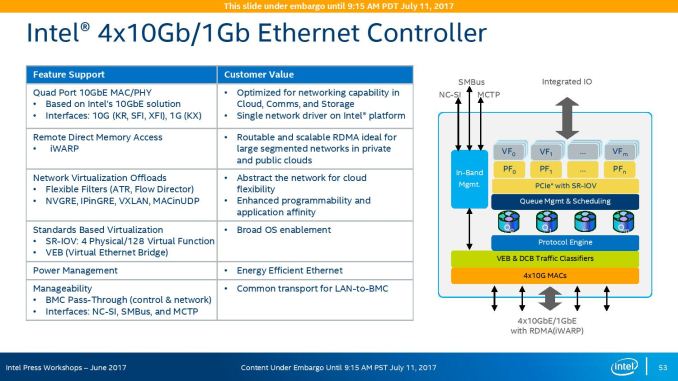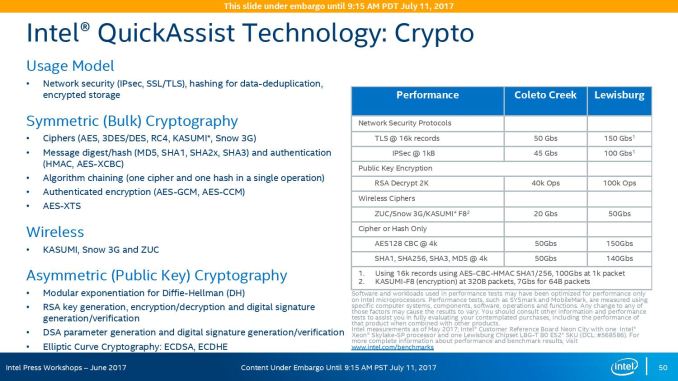Living On The Edge: Intel Launches Xeon D-2100 Series SoCs
by Ian Cutress on February 7, 2018 9:00 AM ESTEthernet Support
One of the benefits to the previous generation of Xeon D was its support for dual 10 gigabit Ethernet controllers integrated into the processor, thus only requiring PHY (physical layer) chips for support. For almost all of the processors in the stack, that moves up to quad 10GbE support, either through copper or fiber. These ports also support accelerated Remote Direct Memory Access (RDMA) and native Software Fault Isolation (SFI).

Taken from our Skylake-SP workshop slide decks
We confirmed with Intel that any third party PHY can be used, not just Intel. Some vendors that have already listed Xeon D-2100 motherboards have included 25 GbE support in their technical specifications – we clarified with Intel that there is no 25 GbE support included on the chip, so those system integrations must be using external MAC/PHYs or PCIe cards in order to include that support.
Intel QuickAssist Technology
On Intel’s QuickAssist Technology: this is still relatively new to most users. QAT is essentially an offload processor for a variety of cryptographic functions, including symmetric/asymmetric encryption, authentication, digital signatures, RSA, ECC, and so on. The idea is this sort of task would normally be handled by the CPU, taking up time and power that could be better spent elsewhere, and that a dedicated engine to this (QAT) would be faster and more power efficient. Intel has so far deployed QAT in its Denverton Atom C3000 series processors, Xeon Scalable chipets, and add-in PCIe cards, but it now comes to the Xeon D-2100 series as well. It was not present on the original D-1500 series processors, however Intel did have mid-cycle updates (such as the D-1553N) which had 40 Gbps QAT support.
 Taken from our Skylake-SP workshop slide decks
Taken from our Skylake-SP workshop slide decks
The implementation of QAT on the Xeon D-2100 series uses its own PCIe 3.0-like interconnect inside the chip, although Intel did not elaborate as to what this entails. We do know that for the Xeon Scalable chipset implementations, the chipset requires up to 16 lanes of PCIe 3.0 to accelerate QAT, so we do expect that Intel is using the equivalent in bandwidth. We have asked for more information, as to whether the QAT engine is actually on chip, or if the PCIe silicon variant is part of the package. I would expect the former, although the latter is easier - this could be identical to the Xeon-SP 18-core silicon found in the enterprise processors, that already have 16 on-package lanes set aside for OmniPath Fabric.
It is worth noting that 100 Gbps QAT support is only for a couple of the Xeon D-2100 processors, with a couple of others giving 40 Gbps and 20 Gbps.










22 Comments
View All Comments
Threska - Wednesday, February 7, 2018 - link
" From a pure price perspective, this jump from the top core count part down to the one just below it is sizable, although Intel does have a history with this, such as the E3-1200 Xeon line where the top processor, with a 100 MHz higher frequency than the second best, was 30%+ higher in cost."Must be nice having a monopoly.
Qwertilot - Wednesday, February 7, 2018 - link
That's not a monopoly thing as, by definition, they provide very, very strong competition to themselves :) Some customers are presumably truly price insensitive for whatever reason.Elstar - Wednesday, February 7, 2018 - link
If all you care about is upfront costs, then yes, Intel's high-end parts are expensive. But if you run a data center where "performance/watt" is critical, then the cost of the top parts are reasonable.Elstar - Wednesday, February 7, 2018 - link
If all you care about is upfront costs, then yes, Intel's high-end parts are expensive. But if you run a data center where "performance/watt" is critical, then the cost of the top parts are reasonable.tamalero - Sunday, February 11, 2018 - link
I'm confused how 4 cores less but 600Mhz less per core on base frequency and all turbo is "better performance per watt" while being almost 1400 USD more per processor.HStewart - Wednesday, February 7, 2018 - link
"Must be nice having a monopoly."Well anybody that states Intel has a monopoly should rethink that, even Apple could be consider a Monopoly because they don't allow others to manufacture products on iOS - but the one that comes to mind the most is Qualcomm with recent announcements of Windows 10 for ARM - which only works on Qualcomm.. Can we say Windows 10 for Qualcomm - sorry no thanks
But the real thing that make Qualcomm a real monopoly is it telecommunications.
prisonerX - Friday, February 9, 2018 - link
I guess you can argue what a monopoly is, but Intel is irrefutably abuses their dominant position in the marketplace. The former is not a sin, the later is illegal. Intel is repugnant.Yorgos - Wednesday, February 7, 2018 - link
"Living on the Edge"Right on.
Will it work? will it get infested due to the various sec. holes? will it get bricked like their C2000 cousins?
You can never tell what's going to come tomorrow when you use intel.
Living on the Edge.
HStewart - Wednesday, February 7, 2018 - link
I think you are trying to referred to Atom bases servers - they have been replace with C3xxx versions like 16 Corehttps://ark.intel.com/products/97927/Intel-Atom-Pr...
But if these new D series Xeons have lower power - I could see them replace C2000 cousins. or this Atom based server
DanNeely - Wednesday, February 7, 2018 - link
Looks like only 14 D2xxx CPUs (in all the tables/charts) not 15 as stated in the section header.